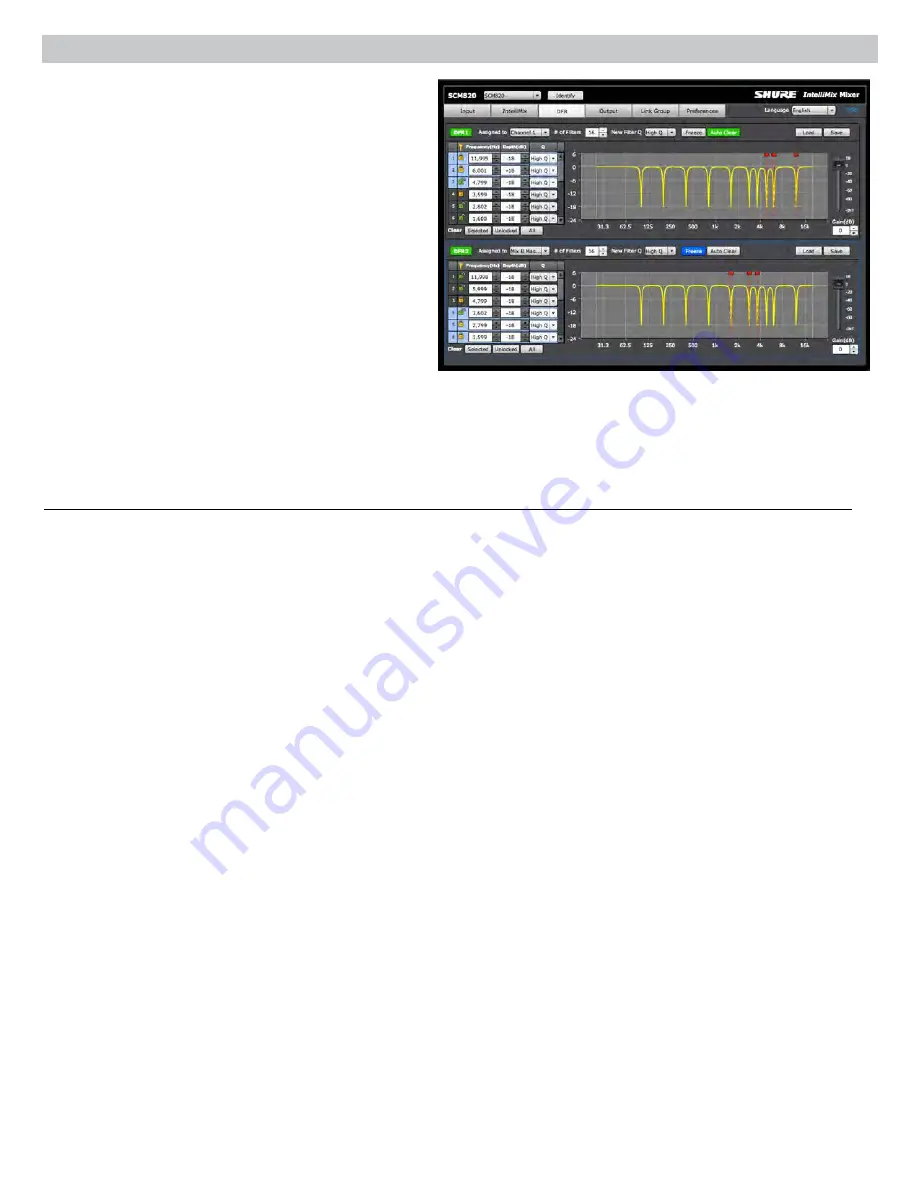
17
Digital Feedback Reduction (DFR)
DFR uses Shure’s patented Adaptive Notch Filter algorithm to
discriminate between feedback and non-feedback sounds. It
automatically detects feedback and deploys narrow-band notch filters
at the feedback frequencies. DFR filters are narrow enough to prevent
any coloration of the audio program.
No sound system (the combination of microphones, mixing, signal
processing, power amplifiers, loudspeakers and room acoustics)
produces an absolutely flat response. When the level of a sound
system is increased, the frequencies at which peaks occur will be the
first to exceed the threshold of feedback. The DFR attenuates these
frequencies, flattening the response of the sound system and enabling
operation at a higher overall level.
Function
Use DFR as the initial processor on any channel that receives signal
from a live microphone where feedback is problematic. When DFR
detects feedback, it inserts a shallow, narrow filter into the audio
path to reduce gain at the feedback frequency. This filter is called a
notch filter, due to the narrow section of the frequency spectrum it
affects. The notch automatically deepens if feedback continues on that
frequency.
Basic DFR Setup
Digital Feedback Reducer will not enable you to increase system gain
beyond the physical limits of the sound system. In most cases, you reach
a point of diminishing returns after five to eight notch filters are set. This
is because there are usually only a few dominant peaks in the response
of the system. In most cases, you can expect a 6 dB to 9 dB improvement
in gain-before-feedback by using the DFR. When you are ringing out the
system and notice that many frequencies feedback simultaneously, you
have reached the point of diminishing returns. If at this point the system still
has insufficient gain before feedback, other changes must be made to the
sound system, such as changing the placement of the microphones and/or
loudspeakers.
There are two basic ways in which to set-up the DFR to reduce feedback;
the Ring-Out Method and the Insurance Policy Method:
• Ring Out Method - With this method, you use the DFR as a preemptive
measure against feedback for input channels that operate near the
feedback point and need an extra margin of stability. Using this
method, you raise the channel’s gain beyond its normal setting to
deliberately make the system feed back. The DFR will then set the
proper filters. Then, when you reduce the input gain to an appropriate
level, the system is stable and usable.
• Insurance Policy Method - With this method, you use the DFR as
added insurance against unexpected feedback in an otherwise stable
system. Simply place the DFR processor in the signal path, without
defining any settings. This method is used for systems which already
have sufficient gain-before-feedback, but need protection from
occasional feedback occurrences due to non-stationary microphones or
user-adjustable gain controls.
To ring out the system:
1. Remove any active filters by clicking the Clear All button.
2. Place microphones at their intended locations.
3. Set the mixer to Manual to open all mics.
4. Slowly raise the gain of the sound system while talking or clapping into
the microphones.
5. Assign the DFR to the channel that begins to feed back. If multiple
microphones feed back in the same frequency, assign the DFR to the
mix bus.
6. The DFR processor will deploy notch filters to attenuate the feedback
frequencies.
7. Once the system has stopped feeding back, you can continue by further
raising the level and repeating the process for additional frequencies.
Typically you can raise the gain 3 dB to 9 dB above the level at which
feedback first occurred.
8. Lock the deployed filters so they are fixed. The remaining Unlocked
(Dynamic) filters will deploy as needed when the system is in use.
Note: Depending on the setup of the sounds system, the main PA signal
may be separate from the monitor mix signal. Each feedback path should
include a DFR for the maximum gain before feedback.






























